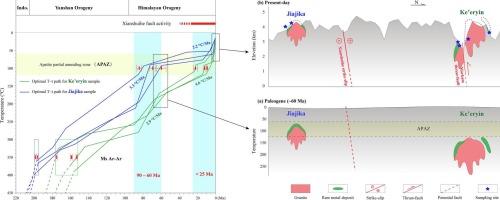Meso–Cenozoic exhumation and preservation of rare metal deposits in the eastern Tibetan Plateau, Southwest China: Insights from fission track thermochronology
IF 3.6
2区 地球科学
Q1 GEOLOGY
引用次数: 0
Abstract
The eastern part of the Songpan–Garze–Tianshuihai orogenic belt (E-SGTOB) is a significant source of pegmatitic rare metal resources. Serving as a critical stress release zone and tectonic transfer corridor in the eastern Tibetan Plateau, the E-SGTOB has experienced multiple periods of thrust nappe formation, uplift, and exhumation, accompanied by extensive strike-slip and thrust fault development during the Meso–Cenozoic era. These complex geological processes have profoundly influenced the formation, evolution, and spatial distribution of mineral resources in the region. However, research on the exhumation history and preservation conditions of rare metal deposits in this area remains limited. To clarify the impact mechanisms of the tectonic evolution of the Tibetan Plateau on the formation and preservation of rare metal deposits, this study reconstructs the cooling history of the Jiajika and Ke’eryin deposits via apatite fission track (AFT) dating and examines the uplift–exhumation processes of the E-SGTOB. The main research findings are as mentioned. (i) The AFT ages of Jiajika and Ke’eryin samples range from 84.12 Ma to 61.27 Ma and from 23.27 Ma to 9.29 Ma, respectively. (ii) Thermal modeling reveals two notable stages of rapid exhumation in the E-SGTOB during the Meso–Cenozoic era. The first stage, during the Late Cretaceous (ca. 90–60 Ma), involved significant exhumation in the Jiajika area, with an average cooling rate of ∼ 3.3 °C Ma−1. However, AFT data from the Ke’eryin deposit show no evidence of this thermal event, suggesting that Late Cretaceous exhumation was spatially restricted. The second stage, from the Neogene to the present (<25 Ma), was characterized by intense tectonic activity in the eastern Tibetan Plateau due to the far-field effects of the India–Eurasia continental collision. During this period, the pegmatite-type rare metal deposits of the E-SGTOB were extensively exhumed to surface levels. The cooling rate in the Ke’eryin area exceeded 4.6 °C Ma−1, considerably higher than the 2.2 °C Ma−1 observed in the Jiajika area. (iii) The preservation of deposits in the E-SGTOB was jointly constrained by the regional tectonic evolution of the Tibetan Plateau and local tectonic patterns of the eastern Tibetan Plateau. After the completion of the Indosinian orogeny and before the Neogene period (∼25 Ma), the long-term tectonic stability in the Tibetan Plateau created a favorable condition for the preservation of deposits. After the Neogene (25–0 Ma) and during the late Himalayan orogeny, amidst intense tectonic activity, the rare metal deposits located in the regions of weak deformation with a low exhumation rate or in highly hidden geological settings exhibited favorable preservation conditions.

青藏高原东部中新生代稀有金属矿床的发掘与保存:裂变径迹热年代学的启示
松潘—甘孜—天水海造山带东段是伟晶质稀有金属资源的重要产地。作为一个关键应力释放区和构造传输走廊的青藏高原东部,E-SGTOB经历了多个推力推覆体形成的时期,隆起,和发掘,伴随着大量的新生代时期走滑逆冲断层发展。这些复杂的地质作用深刻地影响了该地区矿产资源的形成、演化和空间分布。然而,对该地区稀有金属矿床的发掘历史和保存条件的研究仍然有限。为明确青藏高原构造演化对稀有金属矿床形成和保存的影响机制,采用磷灰石裂变径迹(AFT)测年法重建了嘉集卡和柯尔银矿床的冷却史,并考察了E-SGTOB的隆升-发掘过程。主要研究结果如下。(i)佳集卡和柯尔寅样品的AFT年龄分别在84.12 ~ 61.27 Ma和23.27 ~ 9.29 Ma之间。(ii)热模拟揭示了中新生代E-SGTOB的两个显著的快速发掘阶段。第一阶段是晚白垩纪(约90-60 Ma),在嘉集卡地区进行了大量的挖掘,平均冷却速率为~ 3.3°C Ma−1。然而,来自柯尔银矿床的AFT数据没有显示出这一热事件的证据,表明晚白垩世的发掘受到空间限制。第二阶段为新近纪至今(<25 Ma),受印度-欧亚大陆碰撞的远场影响,青藏高原东部构造活动剧烈。在此期间,E-SGTOB的伟晶岩型稀有金属矿床被广泛发掘到地表。柯尔寅地区的降温速率超过4.6°C Ma - 1,明显高于嘉吉卡地区的2.2°C Ma - 1。(3)青藏高原的区域构造演化和青藏高原东部的局部构造格局共同制约了东东段沉积的保存。印支造山运动结束后至新近纪(~ 25 Ma)之前,青藏高原长期的构造稳定为矿床的保存创造了有利条件。新近纪(25-0 Ma)以后和喜马拉雅造山后期,在强烈的构造活动中,位于弱变形、低掘出率或高度隐蔽的地质环境中的稀有金属矿床具有良好的保存条件。
本文章由计算机程序翻译,如有差异,请以英文原文为准。
求助全文
约1分钟内获得全文
求助全文
来源期刊

Ore Geology Reviews
地学-地质学
CiteScore
6.50
自引率
27.30%
发文量
546
审稿时长
22.9 weeks
期刊介绍:
Ore Geology Reviews aims to familiarize all earth scientists with recent advances in a number of interconnected disciplines related to the study of, and search for, ore deposits. The reviews range from brief to longer contributions, but the journal preferentially publishes manuscripts that fill the niche between the commonly shorter journal articles and the comprehensive book coverages, and thus has a special appeal to many authors and readers.
 求助内容:
求助内容: 应助结果提醒方式:
应助结果提醒方式:


